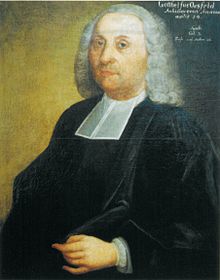Gotthelf Friedrich Oesfeld
Gotthelf Friedrich Oesfeld (born August 31, 1735 in Aschersleben , † June 24, 1801 in Lößnitz ) was a German pastor and an important chronicler of the Ore Mountains .
Life
Oesfeld was born in 1735 as the son of archdeacon Gotthelf Friedrich Oesfeld at the episcopal church in Aschersleben, from whom he also received his first lessons. He attended the Latin school in Wernigerode and enrolled at the age of 16 on May 10, 1751 to study theology at the University of Halle . In 1754 he received his master's degree .
In 1757 Oesfeld began an academic career at the university in Wittenberg . A short time later, however, he moved to Scheibenberg , where he was appointed pastor after a successful trial sermon in 1760. In 1769 he was appointed pastor to Lößnitz and at the same time became inspector of the Schönburg church district.
He began his literary activity in 1765 with the publication of his reflection on the glory of God in the mountain . In 1773 he founded his own magazine (the Erzgebürgische Viewer ), which, however, only appeared for two years. The description of the famine in the Ore Mountains in the years 1771–72 is of lasting importance . His main work is the historical description of some strange cities in the Ore Mountains , published in two volumes . While the first volume deals with the history of the city of Lößnitz, the second volume also contains short chronicles from neighboring cities such as Schwarzenberg , Scheibenberg , Schlettau , Buchholz , Wolkenstein , Hartenstein , Eibenstock , Schneeberg , Johanngeorgenstadt and Chemnitz . The local researcher Friedrich Hermann Löscher also counted 167 contributions in Dresden. Scholarly Anzeiger between 1768 and 1800. Some of his contributions are written in verse. Oesfeld is an author of chronic literature who is widely respected and cited in historical research in the Ore Mountains and is primarily devoted to theological, ethical and philosophical treatises.
Oesfeld died in Lößnitz in 1801 at the age of 66. In the parish register of his parish, he is honored as follows: “ As a learned writer, he published 34 large and small writings, which were received with applause. As a preacher, he had many talents, especially in his younger years, which he blessed with lively strength his community used. His character was noble and righteous, his mind pious and godly, his heart gentle and very soft. Those who knew him well loved him, that's why uncharacteristic tears of melancholy flow into his crypt. "
Honors
- In Lößnitz a street in the city center after Oesfeld was named Oesfeldstraße .
- At the foot of the south-east wall of St. John's Church in Lößnitz there is a memorial plaque.
Works
Selection:
- Contemplation of the future world , 1765 ( digitized version )
- Contemplation on the glory of God in the mountain - along with an instruction on the sanctification of our walks , 1767
- De Templis Christianorum Praefatus, Dedicationi Templi Academici Wittebergensis Ex Cinere, Quae Dei Gratia Est, Resuscitati, Et Die 6. Aug. 1770. Solenni Ritu Inaugurandi, Ex Animo Plaudit, Eamdemque Inclytae Academiae Wittebergensi. 1770 ( digitized version )
- Erzgebirge spectators , 1773/74
- Historical description of some strange cities in the Ore Mountains - specialty of the Hochgräfl. Schönburg. freyen Bergstadt Lößnitz in the Erzgebirge with its surrounding areas , 1776 ( digitized )
- Doctrine of the immateriality, freedom and immortality of human souls , 1777
- The hard winter in the year 1785 in the Ore Mountains , approx. 1786 ( digitized version )
He also published numerous articles in the Saxon magazines of his time.
literature
- Auer Employment Initiative (Ed.): Small Chronicle of Great Masters Vol. 2, Aue, 2002, pp. 151–154.
- Friedrich Hermann Löscher: Gotthelf Friedrich Oesfeld . In: Sächsisches Kirchenblatt, New Series I, 1937, No. 50 p. 371f and No. 51 p. 379–381.
- G. Becker: Gotthelf Friedrich Oesfeld . In: Glückauf (1996), issue 1, p. 16.
- Michael Wetzel : Gotthelf Friedrich Oesfeld . In: Institute for Saxon History and Folklore (Ed.): Saxon Biography .
Web links
- Literature by and about Gotthelf Friedrich Oesfeld in the catalog of the German National Library
- Literature by and about Gotthelf Friedrich Oesfeld in the Saxon Bibliography
| personal data | |
|---|---|
| SURNAME | Oesfeld, Gotthelf Friedrich |
| BRIEF DESCRIPTION | German pastor and chronicler |
| DATE OF BIRTH | August 31, 1735 |
| PLACE OF BIRTH | Aschersleben |
| DATE OF DEATH | June 24, 1801 |
| Place of death | Loessnitz |

